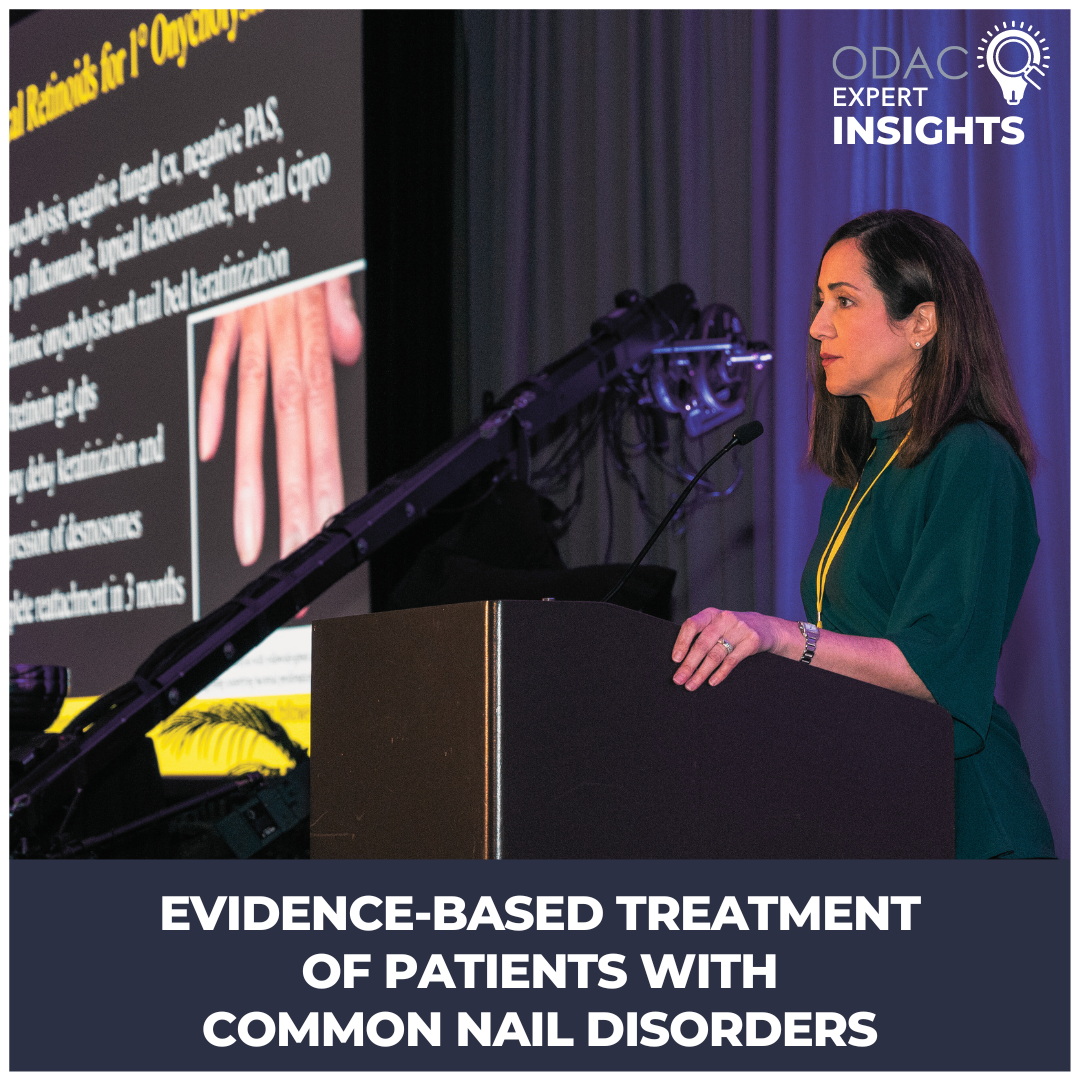At the 2024 ODAC Dermatology, Aesthetic & Surgical Conference, we had the opportunity to learn about treating common nail disorders from Dr. Molly A. Hinshaw, MD, FAAD, Director of Nail Clinic, Section Chief of Dermatopathology, and Professor of Dermatology at the University of Wisconsin School of Medicine. Nail conditions can markedly decrease the quality of life for patients not only due to cosmesis but also due to limiting function of the hands or feet. In addition to making the right diagnosis, caring for nail disorders requires particularly strong trust between the patient and provider, given the long time course often needed to appreciate improvement. Dr. Hinshaw shared her expertise about some of the most common nail pathologies managed by dermatologists, with tips such as photographing surface, side/sagittal, and free margin views to capture the most pertinent details for diagnosis.
Brittle Nails
Nails that split or break easily can be from physiologic fragility that increases with aging and/or from exogenous causes such as wet/friction work or formaldehyde-containing products. The underlying mechanisms include decreased water content and decreased strength of intercellular keratinocyte bridges. Strategies to optimize care for brittle nails include keeping nails short by cutting straight across, using a glass nail file, moisturizing with humectants and occlusives, and using cotton-lined vinyl gloves for wet/friction work.1 Dr. Hinshaw refrains from recommending biotin supplementation due to possibility of skewing cardiac enzyme testing, and she cautions against using nail hardeners, artificial nails, and nail polish because the associated application or removal can worsen or even cause brittle nails.
Onycholysis
When the nail plate is lifted from the nail bed, differentiating between primary and secondary onycholysis is imperative. The lifted nail should be sent for path to rule out onychomycosis, and other associated diagnoses should be considered, such as a local tumor or psoriasis. If the working diagnosis is primary onycholysis, topical retinoids to the distal nail bed can be trialed to increase the expression of desmosomes.2 Dr. Hinshaw additionally recommends avoiding cleaning under the nail with sharp tools, keeping the nail short, and using cotton-lined vinyl gloves for wet/friction work.
Onychocryptosis
Clipping and thinning are key to symptomatic improvement in pincer nails, with pumice and urea as useful options.3 Phenol is a nonsurgical option with better reported outcomes. Dr. Hinshaw demonstrated an example of matrixectomy with a narrow nasopharyngeal calcium alginate tipped applicator to target phenol down to the proximal matrix.4 She cautions that pregnant women should not be in the same room with open phenol.
Paronychia
Dr. Hinshaw approaches inflammation of the nail folds as irritant dermatitis, taking care to rule out signs and symptoms of secondary infection. First-line treatments include high potency topical corticosteroids, with a transition to topical calcineurin inhibitors to attempt to restore the cuticle. She reserves intralesional corticosteroids, oral fluconazole, and removal of hypertrophied folds for refractory cases. If a case is particularly recalcitrant to treatment and isolated to one nail, biopsy should be considered.
Periungual/Subungual Warts
Physically applying the standard topical options to subungual/periungual warts can be cumbersome and ineffective. Dr. Hinshaw suggests compounding cidofovir 1% cream twice daily for 8 weeks. Cidofovir 15mg/mL or candida antigen injections under local anesthesia are additional intralesional options. Although benign verruca associated with the nail are more common, squamous cell carcinoma and amelanotic melanoma should be on the list of differential diagnoses. Lesion persistence despite multiple treatment modalities is a red flag for malignancy.
Nail Psoriasis
The number of nails involved and location of the psoriatic lesion dictate the treatment algorithm for nail psoriasis.5 If more than 3 nails are affected, systemic treatments can be considered, particularly if markedly affecting quality of life. With fewer nails with matrix involvement with or without bed involvement, intralesional corticosteroids or a combination of topical corticosteroids with vitamin D are first-line options. If only the nail bed is involved, topical vitamin D, topical corticosteroids, topical retinoids, topical tacrolimus, or a combination of any of these topicals are reasonable starting points.
In conclusion, nail disorders can be uniquely frustrating and debilitating for patients. Differentiating between primary and secondary causes of nail morphology is crucial to clinching the appropriate diagnosis. Nonresponse to standards of care, particularly if isolated to a single nail, should expand the differential diagnoses to include malignancies and warrant further investigation, such as biopsy.
References
-
- Chessa MA, Iorizzo M, Richert B, et al. Pathogenesis, Clinical Signs and Treatment Recommendations in Brittle Nails: A Review. Dermatol Ther (Heidelb). 2020 Feb;10(1):15-27. PMID: 31749091.
- Dias PCR, Miola AC, Miot HA. Successful management of chronic refractory onycholysis by partial nail avulsion followed by topical tretinoin. An Bras Dermatol. 2019 Jan-Feb;94(1):118-119. PMID: 30726483.
- Sano H, Ogawa R. A novel nonsurgical treatment for pincer nail that involves mechanical force control. Plast Reconstr Surg Glob Open. 2015 Mar 6;3(2):e311. PMID: 25750850.
- Lam C, Billingsley EM. Nasopharyngeal Swab Applicator for Chemical Matricectomy. Dermatol Surg. 2017 Nov;43(11):1400-1401. PMID: 28272085.
- Rigopoulos D, Baran R, Chiheb S, et al. Recommendations for the definition, evaluation, and treatment of nail psoriasis in adult patients with no or mild skin psoriasis: A dermatologist and nail expert group consensus. J Am Acad Dermatol. 2019 Jul;81(1):228-240. PMID: 30731172.
This information was presented by Dr. Molly Hinshaw during the 2024 ODAC Dermatology, Aesthetic and Surgical Conference. The above highlights from her lecture were written and compiled by Dr. Nagasai Adusumilli.
Did you enjoy this article? Find more on Medical Derm topics here.

